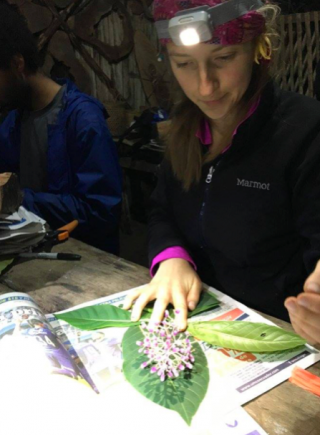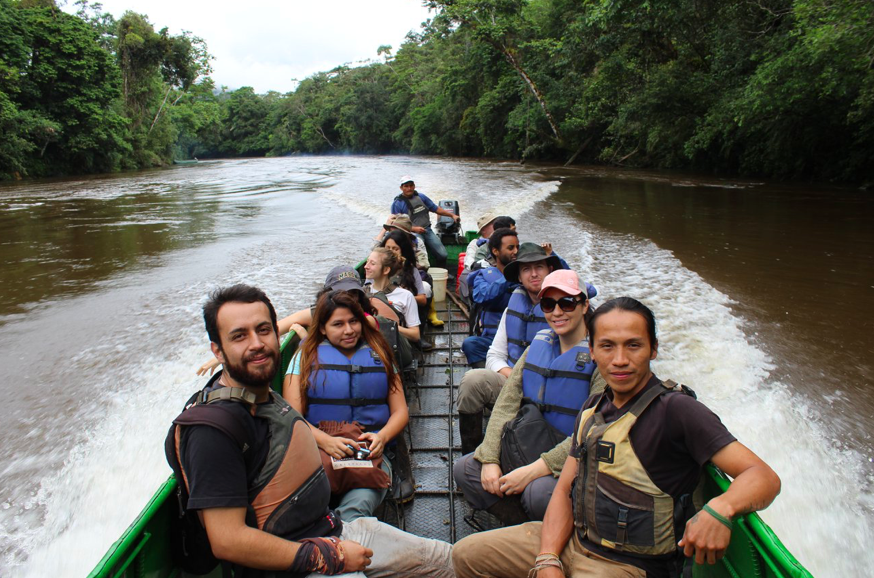Searching for Schefflera in the Ecuadorian Rain Forest
Posted in Interesting Plant Stories on April 5, 2018 by Sarah Hardy
Sarah Hardy is a laboratory technician at the Pfizer Plant Research Laboratory and a former intern at the William and Lynda Steere Herbarium, both at The New York Botanical Garden.

One of the most pressing challenges in botany today is inspiring and training the next generation of systematists, scientists who discover, name, and classify species. In January, an international partnership sought to address this need through a tropical field botany course held in Ecuador for eight graduate students. The program was designed to engage students first-hand with the exciting (and sometimes trying) nature of field collection that is foundational to systematics.
The course was organized by Gregory M. Plunkett, Ph.D., Director and Curator of the Cullman Program for Molecular Systematics at The New York Botanical Garden; Porter P. Lowry II, Ph.D., and M. Marcela Mora, Ph.D., of the Missouri Botanical Garden; and David A. Neill, Ph.D., of Universidad Estatal Amazónica (UEA) in Ecuador with help from Efrén Merino. Of the eight students, four were from the United States and four from Ecuador. They came together at the UEA field station called Centro de Investigación Posgrado y Conservación Amazónica (CIPCA) to learn the logistics of botanical field work, using the genus Schefflera (in the Araliaceae family) as an example. The students brought with them a variety of backgrounds and interests, including plant-insect interactions, lichenology, and conservation, but were eager to get their feet wet in tropical field botany.

The genus Schefflera was selected, in part, because the course fits into a larger National Science Foundation grant to understand the systematics of Neotropical Schefflera by studying their DNA. Taxonomically, Schefflera has had a complicated history, resulting in many of the specimens collected in the New World (and elsewhere) being misidentified or unidentified. This problem is compounded by the fact that Schefflera specimens are sometimes collected improperly and thus lack crucial identifying characteristics, which makes them even more difficult to identify. This problem is compounded by the large number of species found in the Andes of South America, where there are about 250 described species of Schefflera and an estimated 200 more species yet to be described.

To give students some context, the course paired field experience with lectures on the current taxonomic state of Araliaceae and Schefflera, the process of taxonomic revision, the flora and vegetation of Ecuador, and potential career paths in plant systematics. In the field, students surveyed tree plots at the Sumak Kawsay (“good living” in the local Quechua language) field station; learned the morphological features used to identify many tropical plant families; collected Schefflera along trails, roadsides, and rivers; and even found time to snack on guaba fruit growing near field sites.
One of the most physically demanding, and rewarding, days was the hike up a steep Andean tepui in the Cordillera del Cóndor region of southeastern Ecuador. Tepuis are steep sandstone plateaus characterized by distinct and often understudied plant populations due to their inaccessibility (you may recall the Venezuelan tepuis from the movie Up). After five-and-a-half hours of climbing more than 900 meters, we reached the top and were rewarded with stunning views of cloud-covered mountain tops and many specimens that are likely new species in a variety of plant families.
After an intense three weeks together, the team returned to Quito to say our goodbyes, knowing we were forming the next generation of an international network of botanists.
This program was funded by the National Science Foundation with support from The New York Botanical Garden, Missouri Botanical Garden, and Universidad Estatal Amazónica.

